The Lutheran Reformation
The Reformation in Germany was launched by a relatively well-known Augustinian monk who was professor of Scripture at the University of Wittenberg and preacher in the Church of St. Mary’s. Sometime in 1516, Martin Luther (1483-1546) learned that a preacher by the name of John Tetzel was selling indulgences in the nearby town of Jüterbog. Tetzel was claiming that these indulgences guaranteed full remission of sins now and in purgatory, both for those who purchased them and for their deceased loved ones. Confession was unnecessary – even of serious sins!
Luther became concerned that by believing these claims, Christians were deceiving themselves and putting their eternal salvation at risk. In the 95 Theses that he sent to his superior, Archbishop Albert of Brandenburg, and reputedly also nailed to the door of the Castle Church in Wittenberg on October 31, 1517, Luther argued that to be forgiven one’s sins, one had to be truly sorry for having committed them. Beyond that – and this was Luther’s revolutionary claim – one could trust that God was good and gracious and most certainly would grant forgiveness. Salvation did not have to be earned or purchased – it was a gift to be gratefully received. This teaching came to be known as “justification by grace through faith.”
Luther’s 95 Theses set in motion changes in theological teaching, preaching, and worship, and eventually resulted in the formation of distinctively Lutheran churches in many parts of Germany, in Scandinavia, and in what today are the Baltic countries of Estonia and Latvia.
Arrival of Lutheranism in the Ozarks
Lutherans came late to Springfield, Missouri. According to historian Meredith Adams, the railroads facilitated the growth of Ozarks Lutheranism. Prior to their arrival, “There were no large ethnic Lutheran settlements here.” Founded in 1910, Trinity Lutheran Church is the oldest Missouri Synod Lutheran congregation in Greene County. It followed the establishment of churches in Lawrence (Trinity Lutheran in 1874) and Dade counties (Immanuel Lutheran in 1882).
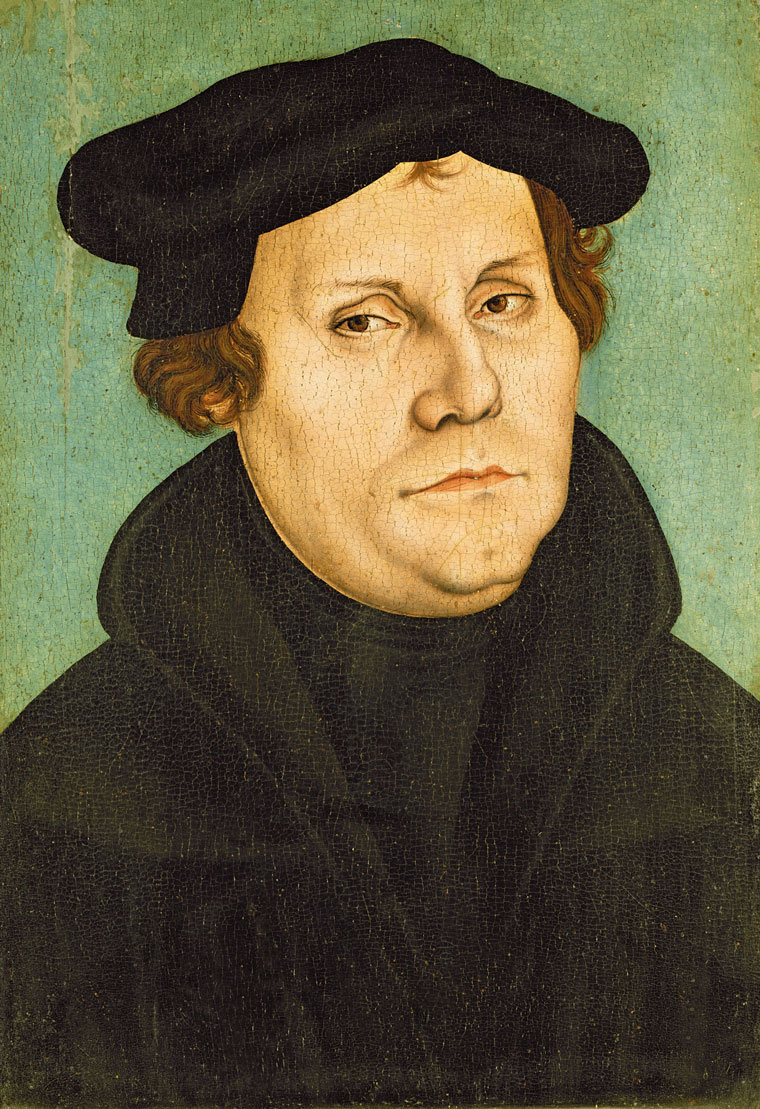
Portrait of Martin Luther
Martin Luther first became known as a writer of prayer books and sermons. Because people wanted to know what this famous professor looked like, his friend the painter Lucas Cranach the Elder (1472-1553) painted portraits of him, and his apprentices reproduced them for distribution and sale in an assembly-line like manner.
Credit: Martin Luther by Lucas Cranach the Elder painted in 1528. Workshop of Lucas Cranach the Elder - The Bridgeman Art Library, Object 308462, Public Domain, https://commons.wikimedia.org/w/index.php?curid=24973472
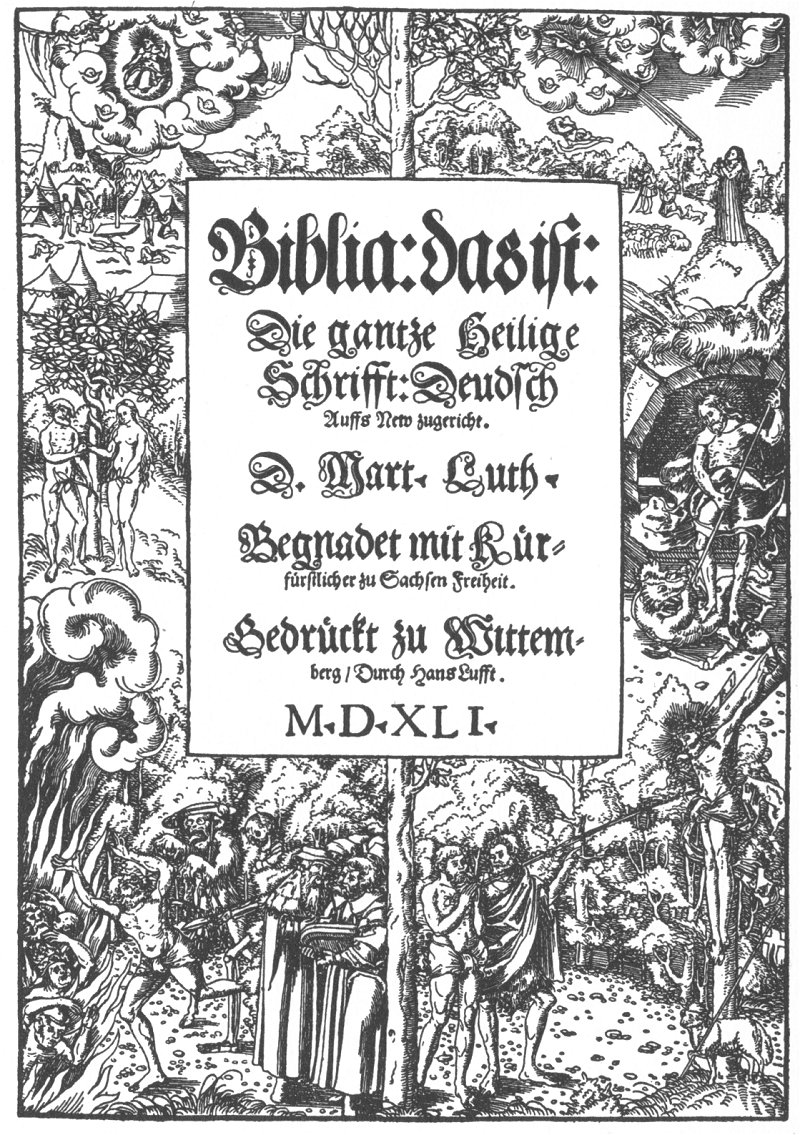
Title Page of Martin Luther’s Complete Bible of 1541
After he was excommunicated from the Church of Rome, and stripped of the protection of the law, Martin Luther spent almost a year, from May 4, 1521 until March 1, 1522, hidden away in a fortress called the Wartburg. During this time, he translated the New Testament from the original Greek into German. The complete Bible in Martin Luther’s translation was first published in 1534. Luther believed that every Christian could read the Bible and find in it the way to a gracious God and eternal salvation.
Credit: Title Page design by Lucas Cranach the Younger [Public domain], via Wikimedia Commons. https://commons.wikimedia.org/wiki/File%3ALuther-Bible-frontispiece-1541.jpg
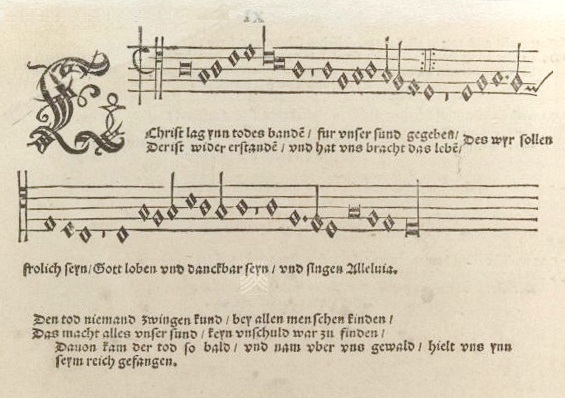
The First Lutheran Hymnal: Geystliches gesangk Buchleyn (1524)
At a time when many people, especially peasants in the countryside, were illiterate, Martin Luther and his colleagues wrote hymns to reach minds and hearts with the Reformation message about a gracious God. The first Lutheran hymnal to be published was the Geystliches gesangk Buchleyn (1524), for which the composer Johann Walther provided the musical notation.
Credit: Tenor voice for Martin Luther’s Easter hymn: “Christ lay in the bonds of death . . .” published in the first Lutheran hymnal Geystliches gesangk Buchleyn (1524). commons.wikimedia.org/wiki/File%3AWalthersches_Gesangbuch_B6v.jpg
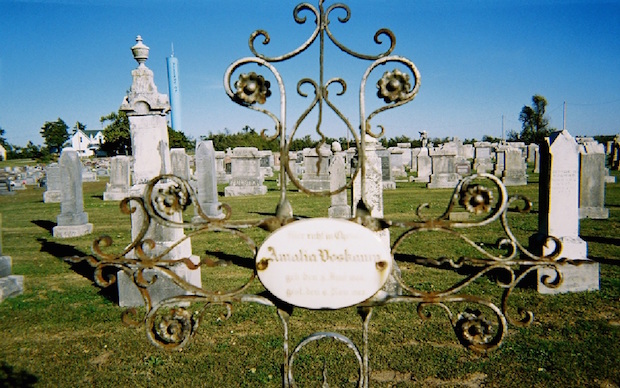
Trinity Lutheran Church cemetery in rural Freistatt, Missouri
Established in 1874. The metal crosses are typical of German-American cemeteries.
Photo by John Schmalzbauer
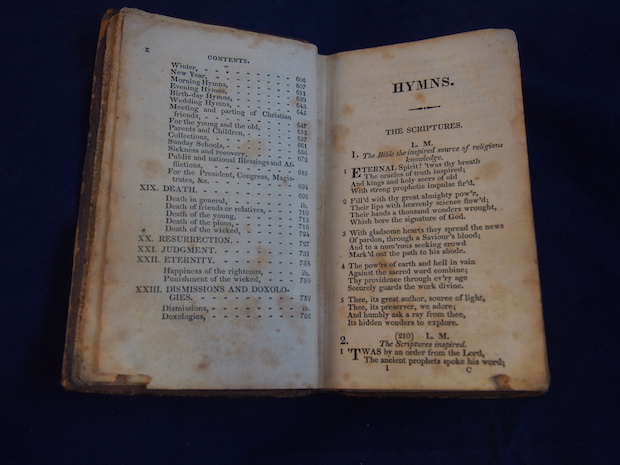
Hymns, Selected and Original, for Public and Private Worship
Eighth Edition. Gettysburg, Pennsylvania: General Synod of the Ev[angelical] Lutheran Church, 1832.
Lent by Dr. Austra Reinis
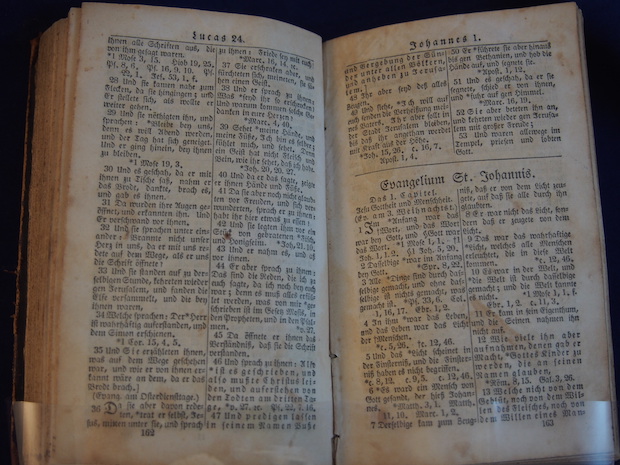
Das Neue Testament unseres Herrn und Heilandes Jesu Christi
(New York: American Bible Company, 1851)
Lent by Mitzi Kirkland-Ives
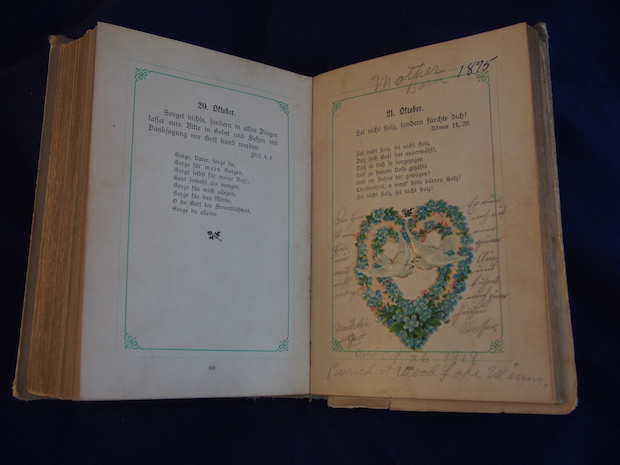
Christliches Gedenkbuch
(New York: Carl Hirsch Publishers, n.d.)
A collection of devotional readings for the layperson for each day of the year
Lent by Mitzi Kirkland-Ives
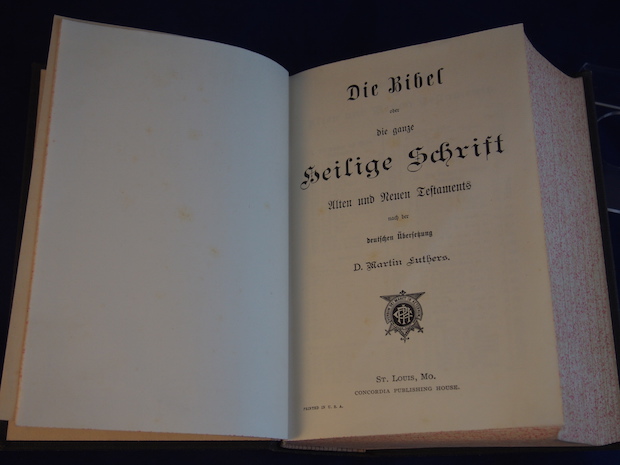
The Bible, ca. 1900, German, translated by Martin Luther
Martin Luther translated the New Testament from Greek into German while holed up at the Wartburg Castle from May 4, 1521 until March 1, 1522. Elector Frederick the Wise had hidden him at the Wartburg for his own safety after the Diet of Worms (1521), at which Luther had been stripped of the protection of the law. Thirteen years later, in 1534, the entire Bible was published.
Property of Meyer Library
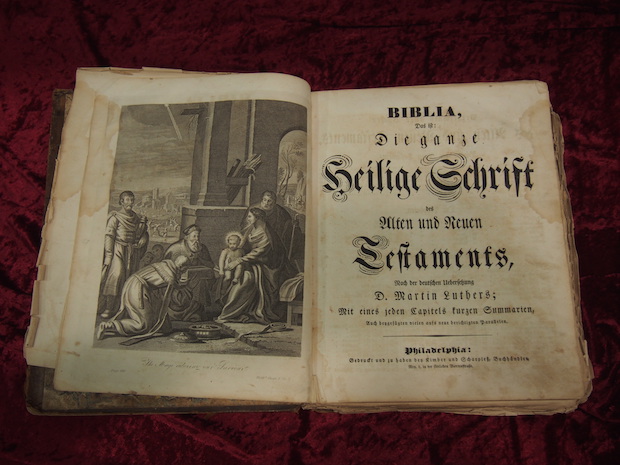
Biblia, das ist: die ganze Heilige Schrift des Alten und Neuen Testaments nach der Deutsche Uebersetzing D. Martin Luthers… [The Bible, that is: the Entire Holy Scripture of the Old and New Testaments after the German Translation of Dr. Martin Luther]
(Philadelphia: Kimber and Scharpless, 1848)
Martin Luther translated the New Testament from Greek into German while holed up at the Wartburg Castle from May 4, 1521 until March 1, 1522. Elector Frederick the Wise had hidden him at the Wartburg for his own safety after the Diet of Worms (1521), at which Luther had been stripped of the protection of the law. Thirteen years later, in 1534, the entire Bible was published.
In the nineteenth century many American publishing houses continued to produce German-language religious texts for the Lutheran community.
Lent by Dr. Mitzi Kirkland-Ives
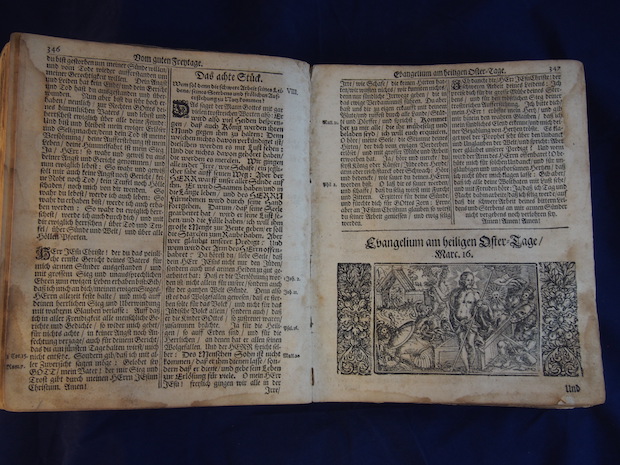
Martin Moller, Praxis Euangeliorum (1601)
Lutherans considered the sermon to be the most important part of the Sunday worship service. Respected preachers, such as Martin Moller (1547-1606) published collections of sermons as to be used as resources by less talented colleagues. This book is a collection of sermons based on the pre-set gospel texts for all the Sundays in the church year.
A number of the 55 woodcuts included in the work are, based on a monogram “signature” included in some of the illustrations, perhaps by the artist Jakob Mores of Hamburg (ca 1540-1612); these woodcuts appeared originally in a series started in 1590 (so the printing blocks would have been still in relatively good condition at the time of this printing), and were reused in a number of prayer and sermon texts like this example.
The woodcut illustration (p. 347) depicts the Resurrection of Christ on Easter morning. Christ carries a banner of victory. Four soldiers surround the tomb. The three Marys watch from within the city gate in the background.
Lent by Suzanne George
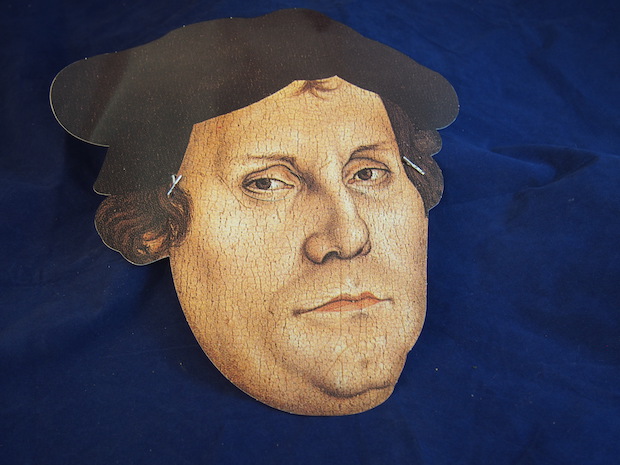
Martin Luther mask from OldLutheran.com
(“The Center for Lutheran pride, but not too proud!”)
Lent by John Schmalzbauer
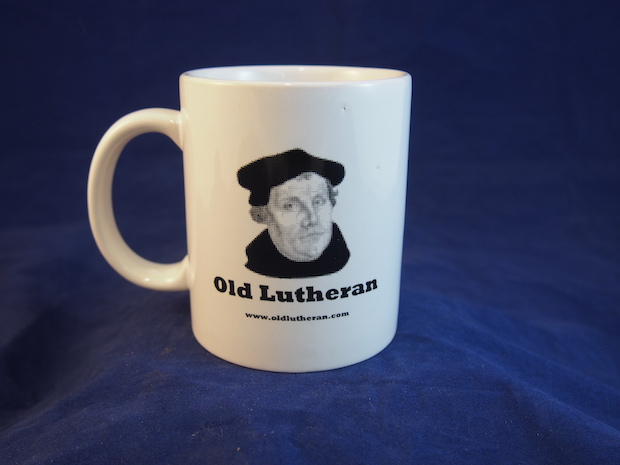
Martin Luther Coffee Mug from OldLutheran.com
Lent by John Schmalzbauer
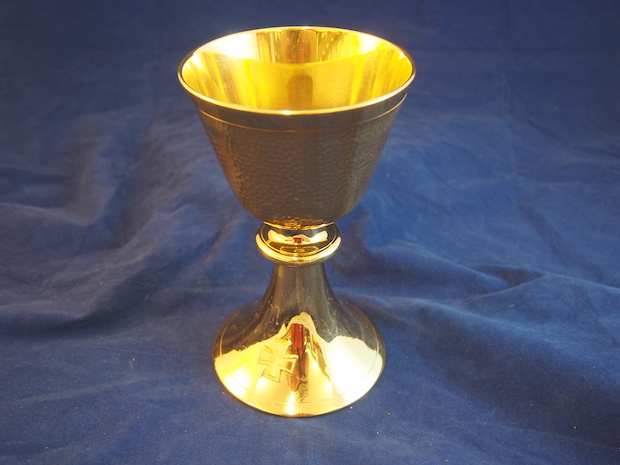
Bronze communion chalice
Communion is the central ritual of all Christian churches, including Prince of Peace Lutheran Church. When they receive a piece of bread and a sip of wine during the communion ritual, Lutherans believe they are receiving the body and blood of Christ, and are assured their sins, or mistakes, are forgiven. Fun fact: This chalice is no longer used because it has rusted inside and makes the wine go bad really fast!
Lent by Prince of Peace Lutheran Church, Springfield, Missouri, founded 1980
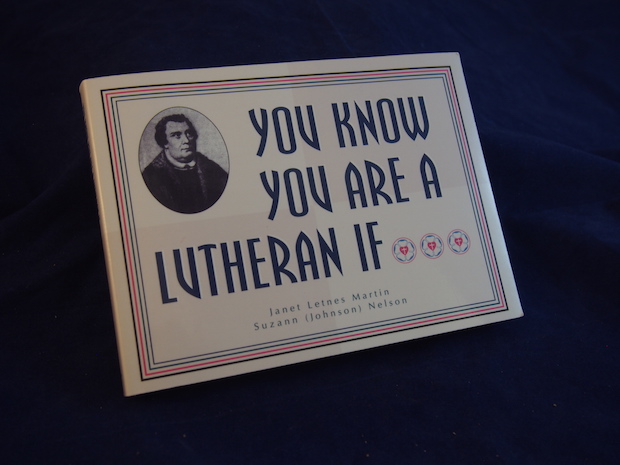
You Know You Are a Lutheran If…
By Janet Letnes Martin and Suzann (Johnson) Nelson (Hastings, MN: Caragana Press, 2002)
Lutheran humor book.
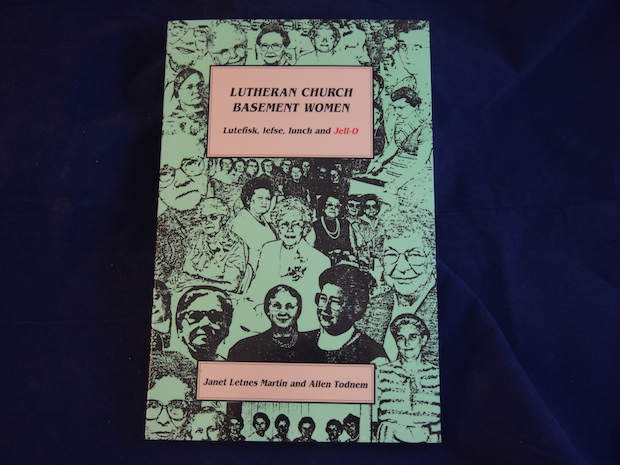
Lutheran Church Basement Women: Lutefisk, Lunch and Jell-O
By Janet Letnes Martin and Allen Todnem (Hastings, MN: Redburd Publications, 1992)
This cookbook title is also the name of a popular Twin Cities theatre production.
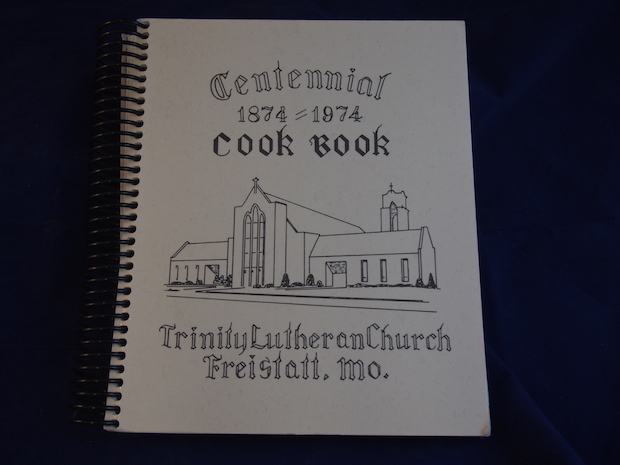
Centennial 1874-1974 Cook Book, Trinity Lutheran Church, Freistatt, Missouri
(Waverly, Iowa: G & R Publishing, 1980).